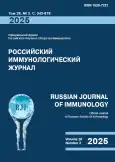Immune cells in experimental model of acute poisoning with acetaminophen
- Authors: Zudova A.I.1,2, Zilber K.Y.2, Mishurin Y.V.2, Apanovich S.V.3, Solomatina L.V.1
-
Affiliations:
- Institute of Immunology and Physiology of the Ural Branch of the Russian Academy of Sciences
- Ural State Medical University
- Yeltsin Ural Federal University
- Issue: Vol 28, No 3 (2025)
- Pages: 495-500
- Section: SHORT COMMUNICATIONS
- URL: https://journal-vniispk.ru/1028-7221/article/view/319891
- DOI: https://doi.org/10.46235/1028-7221-17181-ICI
- ID: 319891
Cite item
Full Text
Abstract
Acetaminophen (paracetamol) is one of the most common analgesic and antipyretic agents. Therefore, the overdosage with this drug are often observed, being associated with acute hepatotoxicity and systemic inflammation, worsening the clinical prognosis. In this case, systemic inflammation is characterised by systemic activation of immune system. However, the contribution of different types of immune cells to pathogenesis of acetaminophen poisoning has not been sufficiently studied thus determining the purpose of this work. The aim of this study was to evaluate changes in the number of cells expressing CD3+, CD20+, CD45+ in organs of C57Bl/6 mice during acute acetaminophen poisoning. The study was performed with sexually mature male C57Bl/6 mice. The mice were divided into 2 groups of 7 mice in each group. The experimental group included animals treated with acetaminophen solution (Sigma-Aldrich, USA) at a dose of 600 mg/kg at (14 mg/mL). An equivalent volume of physiological solution was administered to the control group. The animals were taken out of the experiment after 24 hours, and internal organs were removed. Primary rabbit antibodies from Sigma-Aldrich (C7930), Thermo Fisher Scientific (PA5-16701), Abcam (ab281586) were used for immunohistochemical study for CD3+, CD20+, CD45+ cells. Secondary antibodies were purchased from Thermo Fisher Scientific (31820). When assessing the content of CD20+ cells in organ tissues of C57Bl/6 mice, only single cells were observed in the field of view. Statistically significant differences were not revealed by Mann–Whitney U test thus suggesting absence of B cell contribution to the pathogenesis of acetaminophen poisoning in the first 24 hours. A statistically significant decrease in the number of CD3+ cells in heart tissue was determined. 24 hours after the toxicant administration, an increased number of CD45+ expressing immune cells was noted in liver, mainly, as segmented neutrophils. Hence, we did not find any significant changes in cell numbers of CD3+ and CD20+ expressing cells in the studied tissues by 24 hours after acute acetaminophen poisoning in experimental animals. At the same time, there is an increased content of immune cells in the liver tissue, mainly due to neutrophils.
Keywords
Full Text
##article.viewOnOriginalSite##About the authors
A. I. Zudova
Institute of Immunology and Physiology of the Ural Branch of the Russian Academy of Sciences; Ural State Medical University
Author for correspondence.
Email: tina.zudova@mail.ru
Junior Researcher at the Laboratory of Inflammation Immunology; Assistant Professor at the Department of Normal Physiology
Russian Federation, Ekaterinburg; EkaterinburgK. Yu. Zilber
Ural State Medical University
Email: tina.zudova@mail.ru
Student
Russian Federation, EkaterinburgYa. V. Mishurin
Ural State Medical University
Email: tina.zudova@mail.ru
Student
Russian Federation, EkaterinburgS. V. Apanovich
Yeltsin Ural Federal University
Email: tina.zudova@mail.ru
Student
Russian Federation, EkaterinburgL. V. Solomatina
Institute of Immunology and Physiology of the Ural Branch of the Russian Academy of Sciences
Email: tina.zudova@mail.ru
PhD (Medicine), Senior Researcher at the Laboratory of Inflammation Immunology
Russian Federation, EkaterinburgReferences
- Zudova A.I., Mukhlynina E.A., Solomatina L.V. Experimental model of systemic inflammation during acetaminophen toxicity. Rossiyskiy immunologicheskiy zhurnal = Russian Journal of Immunology, 2024, Vol. 27, no. 3, pp. 421-426. (In Russ.) doi: 10.46235/1028-7221-16654-EMO.
- Sentsov V.G., Gusev K.Y., Davydova N.S., Chekmarev A.V. Paracetamol Poisoning: Epidemiology, Diagnosis, Treatment (Status of the Issue). Uralskiy meditsinskiy zhurnal = Ural Medical Journal, 2024, Vol. 23, no. 6, pp. 108-131. (In Russ.)
- Jaeschke H., Adelusi O.B., Akakpo J.Y., Nguyen N.T., Sanchez-Guerrero G., Umbaugh D.S., Ding W.X., Ramachandran A. Recommendations for the use of the acetaminophen hepatotoxicity model for mechanistic studies and how to avoid common pitfalls. Acta Pharm. Sin. B, 2021, Vol. 11, no. 12, pp. 3740-3755.
- Krenkel O., Mossanen J.C., Tacke F. Immune mechanisms in acetaminophen-induced acute liver failure. Hepatobiliary Surg. Nutr., 2014, Vol. 3, no. 6, pp. 331-343.
- Zotova N., Zhuravleva Y., Chereshnev V., Gusev E. Acute and Chronic Systemic Inflammation: Features and Differences in the Pathogenesis, and Integral Criteria for Verification and Differentiation. Int. J. Mol. Sci., 2023, Vol. 24, no. 2, 1144. doi: 10.3390/ijms24021144.
Supplementary files







